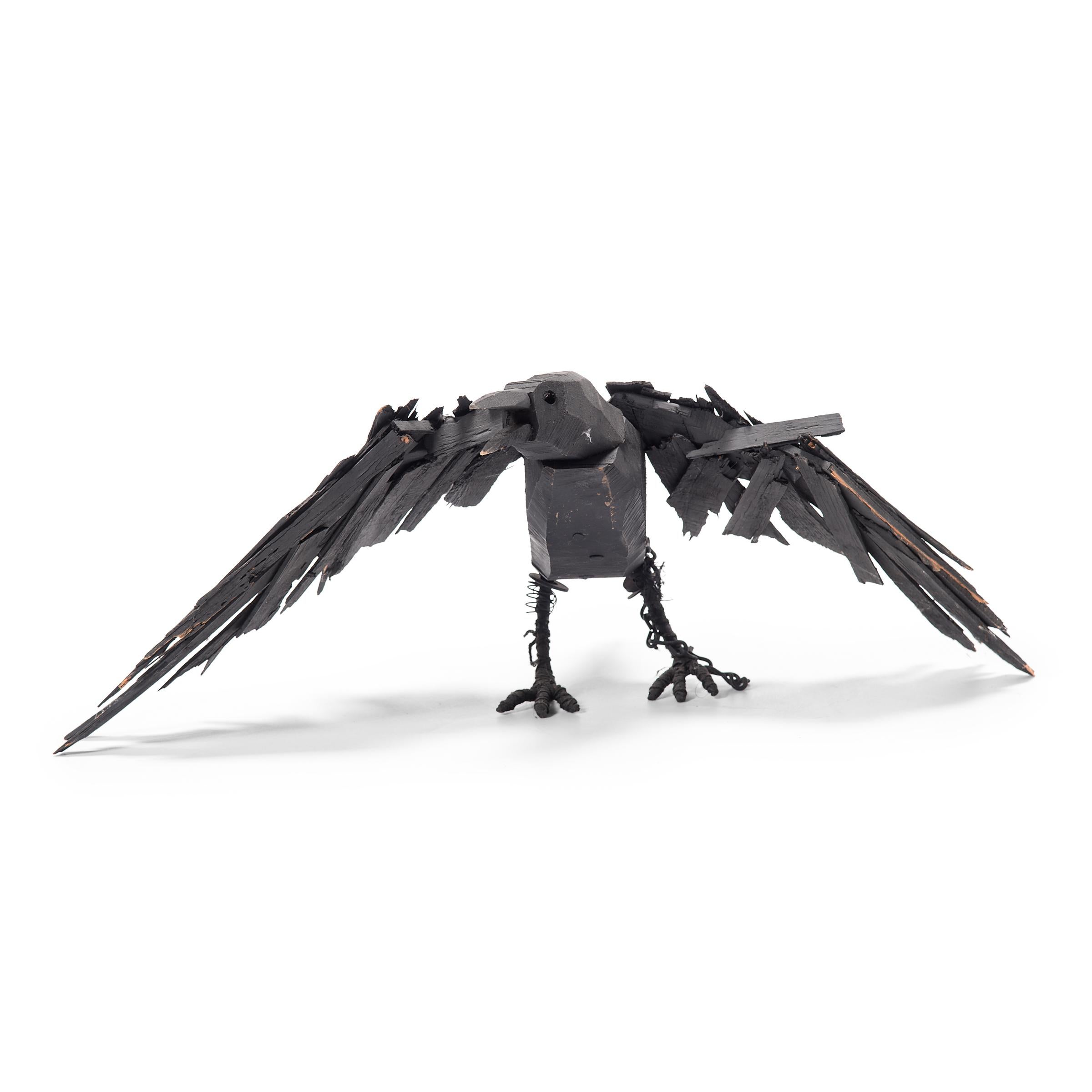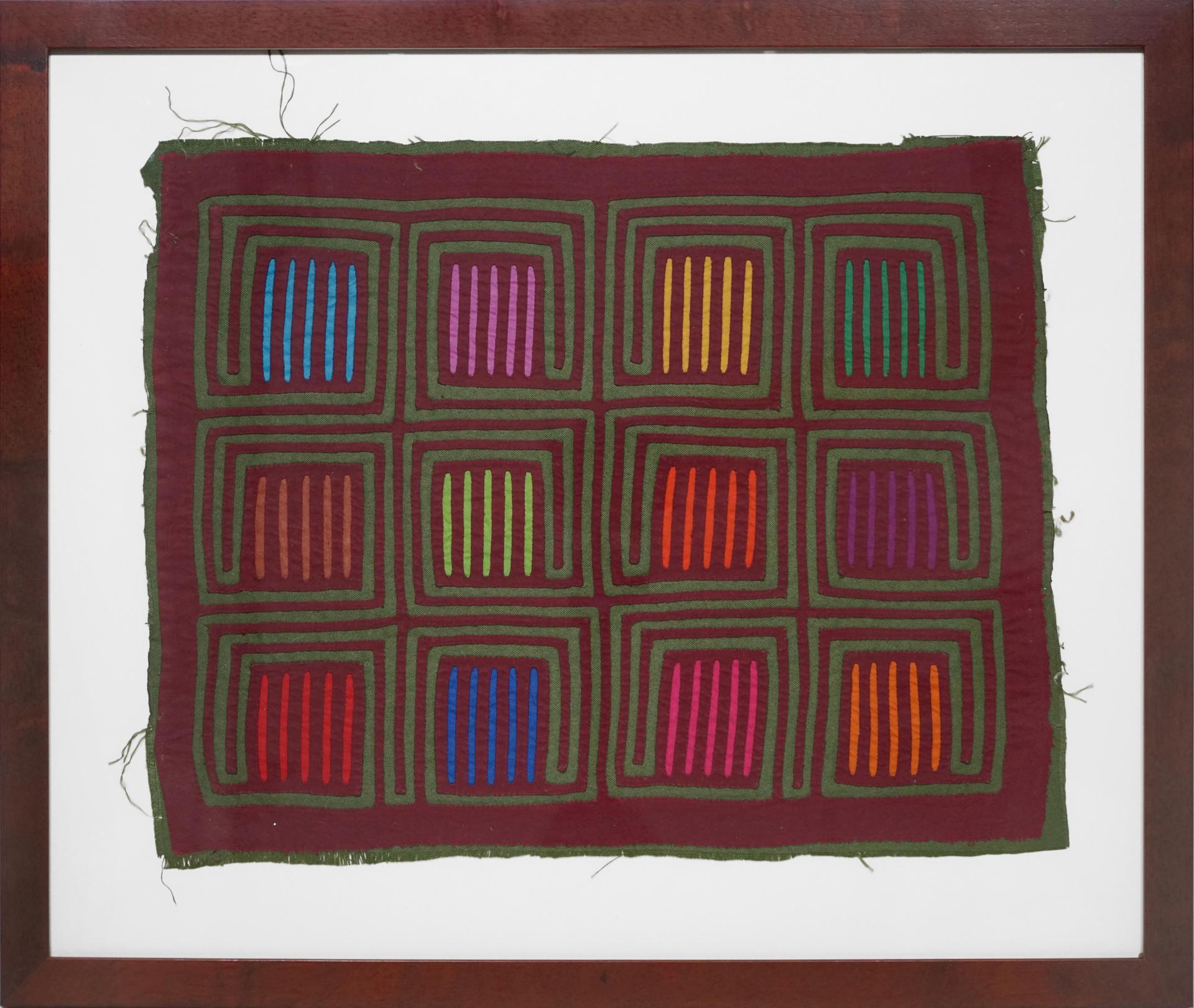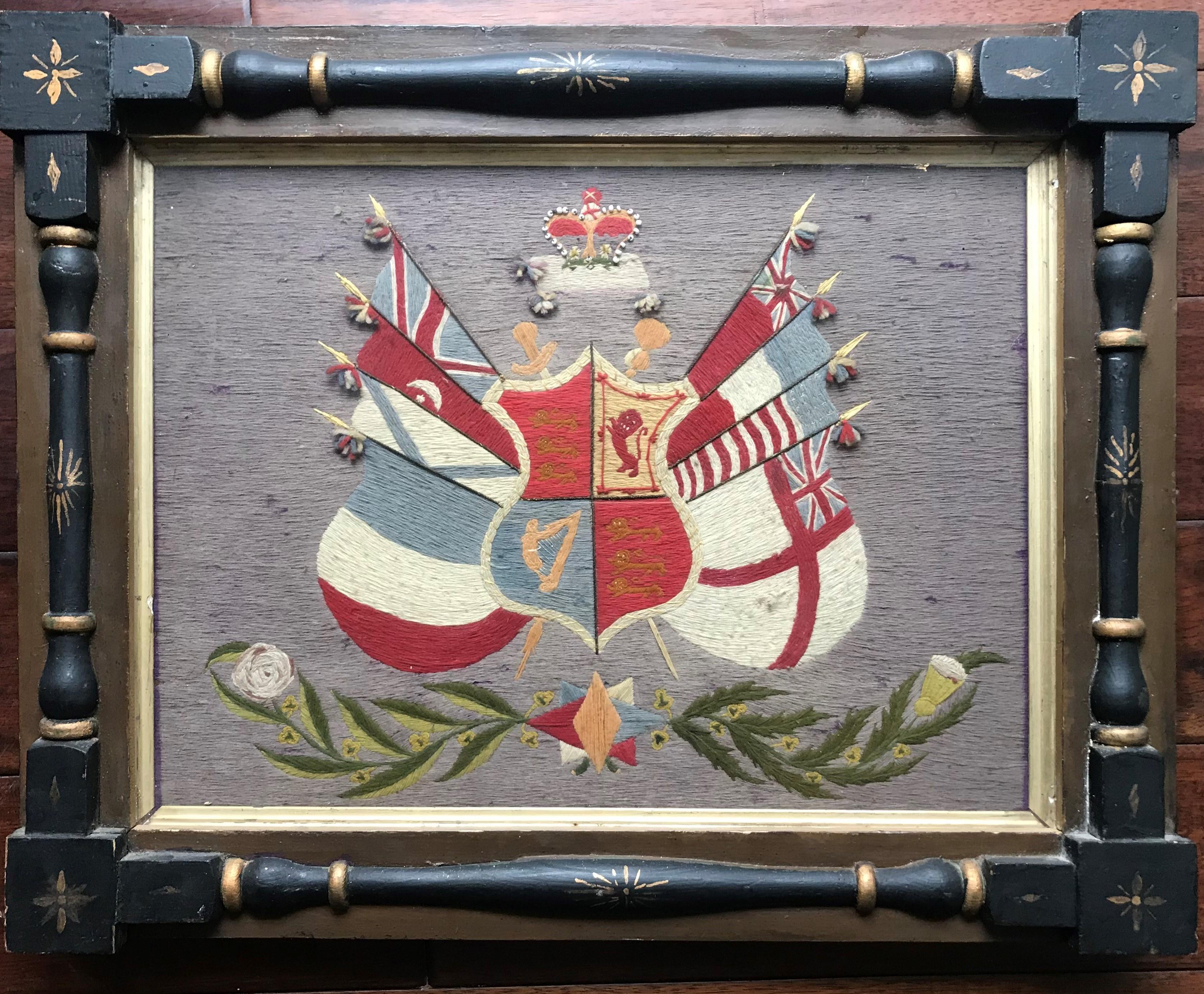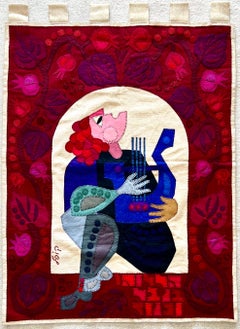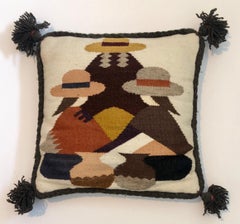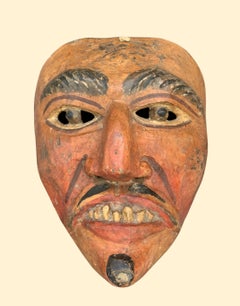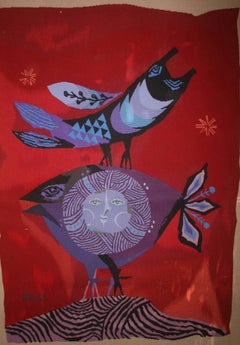
Israeli Bird and Fish Hand Woven Itche Mambush Atelier Aubusson Style Tapestry
View Similar Items
Want more images or videos?
Request additional images or videos from the seller
1 of 5
Sami BrissIsraeli Bird and Fish Hand Woven Itche Mambush Atelier Aubusson Style Tapestry
About the Item
- Creator:Sami Briss (1930, French)
- Dimensions:Height: 56 in (142.24 cm)Width: 42 in (106.68 cm)
- Movement & Style:
- Period:
- Condition:
- Gallery Location:Surfside, FL
- Reference Number:1stDibs: LU382184092
About the Seller
4.9
Platinum Seller
These expertly vetted sellers are 1stDibs' most experienced sellers and are rated highest by our customers.
Established in 1995
1stDibs seller since 2014
1,543 sales on 1stDibs
Typical response time: 1 hour
More From This SellerView All
- Wool Felt Applique Israeli Folk Art Signed Tapestry Kopel Gurwin Bezalel SchoolBy Kopel GurwinLocated in Surfside, FLThis depicts KIng David reciting Psalms, Hallelujah in Hebrew Kopel Gurwin (Hebrew: קופל גורבין) (1923–1990) was an Israeli tapestry wall hanging, painter and graphic artist. Kopel (Kopke') Gurwin (Gurwitz) was born and raised in Vilna, the capital of Lithuania. He spoke Yiddish at home, but simultaneously studied Hebrew at their school which was part of the Tarbut educational network. Kopel was active in the Hashomer Hatzair youth movement. In the 1930s, as a teenager, Kopel helped his parents with the home finances by working in a suit workshop, there he first encountered the art of sewing. With the outbreak of the Second World War and the German invasion of Vilna, the Jews were imprisoned in camps and ghettos. Kopel and his brother Moshe were separated from their parents and were put to work in coal mines and peat. Kopel's parents were taken to the Stutthof Nazi concentration camp where they died of typhus within a month of each other. Kopel's 12-year-old sister Chava was turned over to the Germans by a Polish family and murdered. The brothers were arrested by the Germans, but were saved thanks to the connections of Nina Gerstein, Kopel's drama teacher. They hid in an attic until they were discovered, fled and moved to Riga, where they were caught and sent to the Stutthof concentration camp where they were imprisoned until the end of the war. They were put to work maintaining and cleaning trains and took part in one of the death marches. In July 1946, Kopel and Moshe sailed to Helsingborg, Sweden, as part of operation "Folke Bernadotte", in which Sweden took in ill survivors for rehabilitation. Once he recovered, Kopel worked in a publishing house and later was appointed director of the local branch of the Halutz movement. In 1950 Kopel and Moshe made aliyah to Israel. Kopel worked as a survey for the Survey of Israel Company. In 1951, he enlisted to the Communication Corps and served as a military draftsman. There he won first prize for the design of the front cover of the Communication Corps bulletin. With his discharge from the army at 29 he started studying drawing and graphics at the Bezalel Academy of Arts and Design in Jerusalem. Among his teachers were Isidor Ascheim, Shlomo Vitkin, Yossi Stern and Jacob Steinhardt. At the end of his first year of study, Kopel won the Reuben and Sarah Lif Excellence Award in written studies. During his studies he also won additional prizes: In 1956 he won first prize from the Lethem Foundation in California for poster design. Later the same year, Kopel won the Hermann Struck prize for his drawing on the theme of Jerusalem. In 1957 he won an additional first prize from the Lethem Foundation and second place from the printing company Ortzel for a drawing for a Jewish New Year greeting card. In 1958 he won first prize in a competition to design a poster for Tel Aviv's jubilee. Two years later he won three other awards: First and third prize for designing a poster for Israel Independence Day, celebrating 12 years of the State of Israel. Also that year Kopel won first prize for a poster to mark the 25th Zionist Congress. In 1964 he entered the Independence Day poster competition on the theme of aliyah and won first and second prize. Four years later he again entered the competition on the theme of 20 years of Israel's independence and won first prize. The poster was styled like a Holy Ark curtain with two lions and a menorah at its centre. This poster appeared on the cover of the famous book Jewish Art and Civilization, edited by Geoffrey Wigoder as well as the record Voices of 20 Years, 1948-1968, edited by Yossi Godard. In April 1971 he won first prize in the Independence Day poster competition for the fourth time. Kopel's Folk Art tapestry won the Israeli Independence Day Poster Contest in 1968 With the completion of his studies at Bezalel Kopel moved to Tel Aviv and was hired by Shmuel Grundman's graphics and design studio. Grundman took him to Europe with him to design and supervise the construction of Israeli exhibition pavilions. During his time at Grundman's he discovered the fibrous felt from which he produced most of his wall hangings. At the 1964 Levant Fair exhibition he used felt stuck onto wooden panels for the first time. The first felt wall hanging that Kopel produced was intended for the American Cultural Centre in Jerusalem and its theme was the United States Declaration of Independence. The wall hanging, which measured 2.85 X 1.85 meters, was stuck on a wooden panel. Kopel ordered rolls of felt from France and began work on wall hangings based on bible stories. He used a needle, hand sewing small even stitches with black embroidery thread which framed and highlighted every detail in the work, as well as using appliqué. The interior designer, Alufa Koljer-Elem, introduced him to Ruth Dayan who managed the shop Maskit in September 1967 he opened his first solo exhibition at the Maskit 6 gallery, in which 12 wall hangings were displayed. In light of the exhibition at Maskit 6, Meira Gera, the director of artistic activity at the America-Israel Cultural Foundation, organized an additional exhibition of his works at the foundation's exhibition hall in New York City. The exhibition sparked immense press interest, and was also displayed for a few months at the New York Jewish Museum, from where it travelled throughout the United States. Followed by the exhibition at the Delson-Richter gallery in Old Jaffa, which was later also exhibited at the Jerusalem Theatre. Kopel's tapestry "The Time for Singing has Arrived" was printed on a UNICEF greeting card in 1978 and again in 1981. The Israeli Philatelic Service issued three stamps based on three of Kopel's holy ark curtains and one stamp based on an Independence Day poster he designed. Kopel's creations decorate a large number of synagogues, public buildings, hotels and private collections which were purchased in Israel and around the world. They have decorated, among others, the walls of the King David Hotel in Jerusalem, the VIP room at Ben Gurion Airport, the Kfar Saba theatre and the Plaza Hotel in Tel Aviv. Israel has had a Vibrant Folk Art, Naive art scene for a long time now artists like Israel Paldi, Nahum Guttman, Reuven Rubin had naive periods. The most well know of the strict naive artists are Shalom of Safed, David Sharir, Irene Awret, Gabriel Cohen, Natan Heber, Michael Falk and Kopel Gurwin. Exhibitions: 1995 The Knesset Jerusalem 1988 Temple Beth Shalom Miami, Florida 1988 University of Jewish Studies Los Angeles 1987 Israel Congregation on the Northern Coast Chicago 1985 Jerusalem Theatre Jerusalem 1984 Tenafly New Jersey 1983 Horace Richter Gallery Old Jaffa 1974 Jerusalem Theatre Jerusalem 1974 Delson Richter Gallery Old Jaffa 1972 University of Jewish Studies Miami, Florida 1971 Jewish Museum New York 1970 Norman Gallery Canada 1970 Sharei Tzedek Congregation Winnipeg, Canada 1970 Gallery of the Year Los Angeles 1970 Gallery of the Year Scottsdale 1969 Gleeman Gallery Chicago 1969 Israel Congregation of the Northern Coast Chicago 1967 Maskit 6 Tel Aviv Prizes: 1971 First Independence Day poster 1971, 23 yeaes of the State of Israel 1969 Second International Tel Aviv poster...Category
20th Century Folk Art Mixed Media
MaterialsWool, Felt
- Vintage Handwoven Tapestry Wool Folk Art Rug Weaving Wall Hanging Olga FischBy Olga FischLocated in Surfside, FLOlga Fisch ( American 1901-1990) Hummingbird and Pendant Flower, hand woven and stitched wool and sequins, signed lower right. Dimensions: 58 x 32 in. Olga Fisch was born in Hungary, studied in Germany and lived in Morocco and Ethiopia before receiving asylum as a Jewish refugee in Ecuador in 1939. For her Indian-inspired designs, Mrs. Fisch uses natural black and white sheep...Category
20th Century Folk Art More Art
MaterialsWool
- Vintage Handwoven Tapestry Wool Folk Art Rug Weaving Pillow or Wall HangingBy Olga FischLocated in Surfside, FLOlga Fisch was born in Hungary, studied in Germany and lived in Morocco and Ethiopia before receiving asylum as a Jewish refugee in Ecuador in 1939. For her Indian-inspired designs, Mrs. Fisch uses natural black and white sheep...Category
1950s Folk Art More Art
MaterialsWool
- Hungarian Rabbi Akiba Eger 19thC Judaica Folk Art Tapestry Needlepoint SamplerLocated in Surfside, FLDimensions board backing is 2 X 18.5 board opening is 16.5 X 13 inches 19th Century framed tapestry of a Rabbi, embroidered sampler, with beaded script below. (it reads J. Eger Oberlandes Rabbiner or Oberlander Rabbiner) There is some sort of texture and dimension to his fur hat (Shtreimel) and coat collar. This is being sold without the frame.. Rabbi Akiba Eger (5521-5598; 1761-1838) Rabbi Akiba Eger was one of the greatest scholars of his time, who had a great influence on Jewish life. He was born in Eisenstadt, Hungary, in the year 5521 (1761), nearly two hundred years ago. The city of his birth was a seat of learning for centuries, and his family was a family of scholars and Rabbis.Rabbi Akiba Eger, who was Rabbi in the famous community of Pressburg (also Hungary, but since 1913 it belonged to Czechoslovakia and was called Bratislava). He was invited to become Rabbi of the famous city of Posen, and in fact became the chief rabbi of the entire Posen province, though he did not carry that title. His famous son-in-law, Rabbi Moshe Sofer (known as the 'Chasam Sofer'), Rabbi of Pressburg, who had married Rabbi Akiba Eger's daughter. King Frederick III of Prussia honored him with a special medal. Rabbi Akiba Eger was recognized as a great authority on Jewish law, and many well known rabbis and Jewish leaders turned to him for advice and decisions on points of law. "This sort of art, craft work, emerges from a long tradition of Jewish folk art...Category
Early 1900s Folk Art More Art
MaterialsWool, Mixed Media, Thread
- Wool Felt Craft Applique Vintage Israeli Judaica Folk Art Tapestry Kopel GurwinBy Kopel GurwinLocated in Surfside, FLThis depicts King David playing the harp, along with a verse in Hebrew from the Psalms. all made by hand. woven and stitched. Vintage, original piece. Kopel Gurwin (Hebrew: קופל גורבין) (1923–1990) was an Israeli tapestry wall hanging, painter and graphic artist. Kopel (Kopke') Gurwin (Gurwitz) was born and raised in Vilna, the capital of Lithuania. He spoke Yiddish at home, but simultaneously studied Hebrew at their school which was part of the Tarbut educational network. Kopel was active in the Hashomer Hatzair youth movement. In the 1930s, as a teenager, Kopel helped his parents with the home finances by working in a suit workshop, there he first encountered the art of sewing. With the outbreak of the Second World War and the German invasion of Vilna, the Jews were imprisoned in camps and ghettos. Kopel and his brother Moshe were separated from their parents and were put to work in coal mines and peat. Kopel's parents were taken to the Stutthof Nazi concentration camp where they died of typhus within a month of each other. Kopel's 12-year-old sister Chava was turned over to the Germans by a Polish family and murdered. The brothers were arrested by the Germans, but were saved thanks to the connections of Nina Gerstein, Kopel's drama teacher. They hid in an attic until they were discovered, fled and moved to Riga, where they were caught and sent to the Stutthof concentration camp where they were imprisoned until the end of the war. They were put to work maintaining and cleaning trains and took part in one of the death marches. In July 1946, Kopel and Moshe sailed to Helsingborg, Sweden, as part of operation "Folke Bernadotte", in which Sweden took in ill survivors for rehabilitation. Once he recovered, Kopel worked in a publishing house and later was appointed director of the local branch of the Halutz movement. In 1950 Kopel and Moshe made aliyah to Israel. Kopel worked as a survey for the Survey of Israel Company. In 1951, he enlisted to the Communication Corps and served as a military draftsman. There he won first prize for the design of the front cover of the Communication Corps bulletin. With his discharge from the army at 29 he started studying drawing and graphics at the Bezalel Academy of Arts and Design in Jerusalem. Among his teachers were Isidor Ascheim, Shlomo Vitkin, Yossi Stern and Jacob Steinhardt. At the end of his first year of study, Kopel won the Reuben and Sarah Lif Excellence Award in written studies. During his studies he also won additional prizes: In 1956 he won first prize from the Lethem Foundation in California for poster design. Later the same year, Kopel won the Hermann Struck prize for his drawing on the theme of Jerusalem. In 1957 he won an additional first prize from the Lethem Foundation and second place from the printing company Ortzel for a drawing for a Jewish New Year greeting card. In 1958 he won first prize in a competition to design a poster for Tel Aviv's jubilee. Two years later he won three other awards: First and third prize for designing a poster for Israel Independence Day, celebrating 12 years of the State of Israel. Also that year Kopel won first prize for a poster to mark the 25th Zionist Congress. In 1964 he entered the Independence Day poster competition on the theme of aliyah and won first and second prize. Four years later he again entered the competition on the theme of 20 years of Israel's independence and won first prize. The poster was styled like a Holy Ark curtain with two lions and a menorah at its centre. This poster appeared on the cover of the famous book Jewish Art and Civilization, edited by Geoffrey Wigoder as well as the record Voices of 20 Years, 1948-1968, edited by Yossi Godard. In April 1971 he won first prize in the Independence Day poster competition for the fourth time. Kopel's Folk Art tapestry won the Israeli Independence Day Poster Contest in 1968 With the completion of his studies at Bezalel Kopel moved to Tel Aviv and was hired by Shmuel Grundman's graphics and design studio. Grundman took him to Europe with him to design and supervise the construction of Israeli exhibition pavilions. During his time at Grundman's he discovered the fibrous felt from which he produced most of his wall hangings. At the 1964 Levant Fair exhibition he used felt stuck onto wooden panels for the first time. The first felt wall hanging that Kopel produced was intended for the American Cultural Centre in Jerusalem and its theme was the United States Declaration of Independence. The wall hanging, which measured 2.85 X 1.85 meters, was stuck on a wooden panel. Kopel ordered rolls of felt from France and began work on wall hangings based on bible stories. He used a needle, hand sewing small even stitches with black embroidery thread which framed and highlighted every detail in the work, as well as using appliqué. The interior designer, Alufa Koljer-Elem, introduced him to Ruth Dayan who managed the shop Maskit in September 1967 he opened his first solo exhibition at the Maskit 6 gallery, in which 12 wall hangings were displayed. In light of the exhibition at Maskit 6, Meira Gera, the director of artistic activity at the America-Israel Cultural Foundation, organized an additional exhibition of his works at the foundation's exhibition hall in New York City. The exhibition sparked immense press interest, and was also displayed for a few months at the New York Jewish Museum, from where it travelled throughout the United States. Followed by the exhibition at the Delson-Richter gallery in Old Jaffa, which was later also exhibited at the Jerusalem Theatre. Kopel's tapestry "The Time for Singing has Arrived" was printed on a UNICEF greeting card in 1978 and again in 1981. The Israeli Philatelic Service issued three stamps based on three of Kopel's holy ark curtains and one stamp based on an Independence Day poster he designed. Kopel's creations decorate a large number of synagogues, public buildings, hotels and private collections which were purchased in Israel and around the world. They have decorated, among others, the walls of the King David Hotel...Category
20th Century Folk Art Mixed Media
MaterialsWool, Felt
- Mixed Media Outsider Art Original Photo Collage Painting Brooklyn Bridge 2 SidedBy Tom CarapicLocated in Surfside, FLThis one is 2 sided with the Brooklyn Bridge on one side and Angkor Wat on the other side. (Angkor is one of the most important archaeological sites in South-East Asia. Stretching over some 400 km2, including forested area, Angkor Archaeological Park contains the magnificent remains of the different capitals of the Khmer Empire, from the 9th to the 15th century. They include the famous Temple of Angkor Wat and, at Angkor Thom, the Bayon Temple with its countless sculptural decorations.) Tom Carapic (born 1939), full name Tomislav Sava Čarapić, is an artist who specialises in found object artwork. He also does street art. A prominent Outsider Artist he was a featured artist in the American Visionary Art Museum's End is Near Exhibit. His work was also featured in the exhibition catalog. His work has been sold at Slotin Folk Art. Carapic was born in Velisevac, Serbia (then Kingdom of Yugoslavia). He was educated at a military school in Herzegovina in the 1950s, and served as a sergeant in the Yugoslav People's Army. Afterwards he was denied a college education, possibly because he was not a member of the Communist Party, illegally crossed into Italy in 1961, and, from there, emigrated to the United States. In 1965, he began attending classes at the New York Art Students League, but dropped out soon afterwards, eventually attending the Wilfred Academy of Beauty Culture. He was unable, however, to find steady beauty parlor employment, and worked in menial labor while attending classes in Spanish Education at Manhattan Community College. Due to a problem with accreditation, he was forced to switch to classes in the field of studio art. There he experienced hallucinatory visions that explained his repeated failures to obtain a degree. In the late 1970s, Carapic began experiencing more hallucinatory visions; claiming that his degree problems were caused when "the evil marriage bureau massed the troops" against his college and proceeded with "an Air force bombardment" of the school. After receiving other visitations, he began making and showing his art. Most of his art is centered on found objects, most famously computer keyboards, especially those by IBM. Most of his art consists of these objects, marked with black Sharpie markers, and with green thumbprints and handprints along the objects. His most famous exhibit in New York City is "Big Bang Theory," a doomsday warnings painted on computer keyboards and shoes and construction debris. Bears similarity to the Art Brut movement made famous by Jean Dubuffet. He was inluded in The End is Near! an exhibit which included an unprecedented group of noted thinkers, from His Holiness the Dalai Lama and Stephen Jay Gould to Reverend Howard Finster and Apocalypse culture expert ,Adam Parfrey, visionary artists brought together by curator, Roger Manley, for an amazing exhibition at the American Visionary Art Museum, the world’s largest ever mounted on the subjects of Apocalypse, Millennium, and Utopia. The End is Near! featuredwork from the following visionary artists amongst others: William Adkins Z.B. Armstrong Bill Bruley Frank Bruno Harry Leroy Brunson Tom Carapic Pierre Carbonel Howard Finster Tim Fowler Mary Mac Franklin Victor Joseph Gatto Robert Gie Patrick Gimel Hugo Hempel Oskar Herzberg Vojislav Jakic Norbert Kox Charles Keeling Lassiter...Category
20th Century Outsider Art Mixed Media
MaterialsPaint, Mixed Media, Photographic Paper
You May Also Like
- Necklace With Cameo Depicting Vesuvius. Late 19th. NaplesLocated in Firenze, ITNecklace with cameo depicting Vesuvius. Antique cameo, hand carved at the end of the 19th century. Central cameo with filigree cast, size h cm 2.5, L 3cm. Hand-engraved cameo on she...Category
Late 19th Century Folk Art More Art
MaterialsGlass, Intaglio
- Guatemala. Maschera di Baila de la Conquista. Inizio XX secoloLocated in Firenze, ITQuesta maschera guatemalteca del inizio del XX secolo, scolpita in legno e utilizzata per la danza della Riconquista (Baila de la Conquista) , raffigura vividamente un uomo europeo, ...Category
Early 20th Century Folk Art Figurative Sculptures
MaterialsWood, Intaglio
- Rare Vesuvius Lava Stone Writing Set. torre Del Greco (naples). XIXLocated in Firenze, ITVery Rare Vesuvius lava stone writing set. Torre del Greco (Naples). 19th century. 4 objects with small sculptures (cameos) depicting the poet Petrarch, mythological female figures, ...Category
Mid-19th Century Folk Art More Art
MaterialsStone, Brass
- Shigaraki Ceramic Ware PitcherLocated in PARIS, FRShigaraki, located in Shiga Prefecture, is renowned for its historical significance in Japanese ceramic art. Shigaraki, counted among Japan's venerable six ancient kilns alongside re...Category
21st Century and Contemporary Folk Art More Art
MaterialsCeramic, Clay, Earthenware
- Bizen Ceramic Ware Avant Garde VaseLocated in PARIS, FRNaoe Koide, a distinguished Bizen Ware Potter, reflected on his lifelong journey, one ignited by a profound curiosity about the concealed marvels within the world. In his childhood, ...Category
21st Century and Contemporary Folk Art More Art
MaterialsCeramic, Clay, Earthenware
- "Protector One" Folk Art Crow SculptureLocated in Chicago, ILRichly textured with whimsical appeal, this late 20th century wooden crow is a delightful example of naive American sculpture. Poised mid-caw, the crow's wings are outstretched, read...Category
Late 20th Century Folk Art Figurative Sculptures
MaterialsWood, Paint
Recently Viewed
View AllMore Ways To Browse
Georges Braque Bird
Hope Bird Sculpture
Red Velvet Flats
Russian Icon Religious
Vintage Aesthetic Tapestry
Tapestry Church
Klee Fabric
Israel Tapestry
Agam Lithographs
Russian Icon 18
Weil Paris
Lurcat Lithograph
Jean Lurcat Lithograph
Japanese Woven Sculpture
Tapestry 70s
70s Tapestry
70s Tapestry
Vintage Fish Fabric



